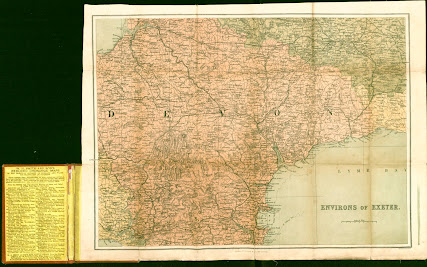John Heywood
John Heywood is
well known for a long-running series of cheap atlases that he published during the
second half of the nineteenth century. Some time between 1852 and 1858 John
Heywood took over the copper plates , or more likely the lithographic stones,
to a series of county maps originally used by Henry Teesdale (B&B
99) and subsequently reissued by Henry George Collins and William S Orr between 1830 and 1850. Heywood made further lithograph
copies of these maps and issued the set as his Travelling Atlas of England & Wales. These were typically on
sale as paperback atlases for the price of 1/-. The stones were used by Heywood until c.1882 with continual updating.
Shortly after the
plates were retired after 50 years of service, John Heywood began to publish a
series of paperback Illustrated Guides. The first guide
seems to have appeared in 1886 with a guide to Llandudno with Heywood’s native
Manchester not appearing until c.1890. A vast number of guides were produced
and from 1891 they included a map: A special
feature of this year's issue is the addition of a two-page map of the place or
district. The aim was that "Each guide has been specially written or
revised for the season. (1897)" There were guides to Torquay (from c.1891),
Ilfracombe (not yet located), and Devonport with Plymouth (see below). The most popular
were reissued up to 35 times with the series running until 1929-30 and a copy
of Torquay from 1922 is known. Besides the Devon towns there were guides to all
the expected tourist destinations but also to such places as Alton Towers.
The series
certainly met with a favourable press: The
Manchester Courier, as early as 1891, wrote that the guides "Contain a
great deal of information concerning the places described which will enable the
visitor to see and know all that is of interest. The guides to localities
within easy distance of Manchester are remarkably valuable." The Pall Mall Gazette was even more lavish
with its praise: "These little books are certainly the cheapest, and are
probably the best, of the kind that are issued." Certainly they were
cheap, being on sale at just one penny or twopence with free post.
Heywood 1 - Torquay
Size: 160 x 220 mm. No scale.
TORQUAY. (Ea). No signature or imprint.
Description: Sketch map of Torquay from just west of the railway line (only Torquay station named) to Kilmorie in the east. Sea front road to Paignton as Cockingston Road (sic). New Pier is shown as straight line with octagon at seaward end. Illustrated.
1. 1891 John Heywood’s Illustrated Guide to Torquay and NeighbourhoodTorquay: Westley's Library. Manchester and London:[1] John Heywood. 1891. KB.
2. 1897 Torre station now shown
and named. New Pier is shown as straight line with a "dog-leg" in the
middle.[2]
John Heywood’s Illustrated Guide to Torquay ...
Manchester and London. [3] John Heywood. 1897. KB.
Heywood 2 - Plymouth and Devonport
John Heywood’s Illustrated Guide to Torquay of 1891 advertises some 49 different titles in the series but the only Devon town included was, in fact, Torquay and Neighbourhood. The series must have been very lucrative as the Torquay guide for 1897 advertises some 130 different titles in the series although both Devonport and Plymouth are listed separately as well as Ilfracombe. The guides were updated frequently: both the text and the advertising sections were expanded or altered. The guides can be fairly accurately dated from railway adverts in the advertising sections.
Size: 160 x 220 mm. No scale.
PLAN OF PLYMOUTH AND DEVONPORT. (Ea). No signature or imprint. Description: Sketch map of Plymouth and Devonport from Hamoaze to Catwater and Cattedown Road in the east.
1. 1894 John Heywood’s Illustrated Guide to Plymouth and DevonportLondon, Liverpool and Bristol. John Heywood. 1894[4]. TQ.
[1] John Heywood gives his
address on the title page as Deansgate and
Ridgefield, Manchster; 1, Paternoster Buildings, London. However the cover
itself has Westley's Library. 10, Strand,
Torquay.
[2] It is interesting to compare
the photographs (by Frith & Co.) on page 4 of each guide. The later picture
clearly shows the new pier and the layout of the extended (reclaimed) gardens
in front of Rock Walk.
[3] John Heywood gives his address on the title page and cover as Deansgate and Ridgefield, Manchster; 29
& 30, Shoe Lane, London, E.C. The map was unchanged for editions from 1897 to 1910 and much of the text
was kept, although some updating did occur.
[4] A railway advertisement is
dated.





Comments
Post a Comment